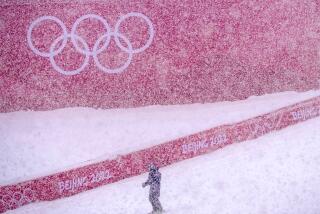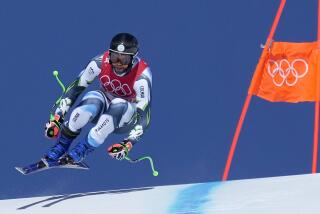Slowdown is in effect in luge competition
Reporting from Whistler, Canada — Putting the brakes on the world’s fastest luge track to prevent the type of crash that killed a young slider during a training run didn’t do much to alter the standings Saturday among the world’s elite sliders after the first two of four runs.
With a light snow falling, Germany’s Felix Loch, who holds the track record of 95.6 mph, was in first place with a combined time of 1 minute 36.570 seconds. Countryman David Moeller, a two-time world champion who finished fifth in the Turin Olympics, is in second, just .282 seconds back. And .150 seconds behind him is Italy’s Armin Zoeggeler, hoping to overtake his rivals to win a third straight gold medal.
The final two runs will begin Sunday at 1 p.m.
Overnight, race officials moved the men’s start about 100 feet lower to the women’s and doubles start, increased the height of walls and reshaped the ice to keep crashing athletes in the track. As a result, speeds decreased from 94 mph to the upper 80s, more in line with World Cup racing.
But even with those precautions, the evening was not without a moment of anxiety during the first round. Spectators gasped as U.S. slider Bengt Walden had trouble steering his sled and bounced off the lip of the track near where Nodar Kumaritashvili lost control of his sled in his fatal crash Friday. Walden crossed the finish line unharmed.
Tony Benshoof, the most decorated U.S. slider, is in seventh place (1:37.404). Chris Mazdzer is in 12th place (1:37.774), Walden in 15th place (1:37.867).
Gordy Sheer, a spokesman for USA Luge and a 1998 Olympic silver medalist, said athletes had been offered counseling but did not know whether any had accepted it.
Athletes wore black bands on their helmets to remember Kumaritashvili, 21, of the Republic of Georgia, who was killed within sight of the finish line when he was catapulted out of the track and into an un-padded roof support beam. His teammate, Levan Gureshidze, withdrew just before the competition began.
But even as the international luge community honored one of its own, officials began calling for changes in how competitions are run and tracks are built.
Ron Rossi, chief executive of USA Luge, said he will propose rules changes to address what he believes are shortcomings and fine track designers for poor work.
“Lots of drivers make errors, but they don’t come flying out of the track,” Rossi said earlier Saturday. “They need to be asking questions about training time, lack of track designer accountability. . . . I’m going to propose rule changes so there is more training time for all.”
International luge officials and executives with the Vancouver organizing committee spent the day trying to put out fires as questions mounted. They released records showing that in 26 runs down the Whistler track, Kumaritashvili, ranked 44th in the world, had crashed in that area at least three times.
At a news conference Saturday morning, Josef Fendt, president of the international luge federation, insisted the track was safe.
“We never said that it was too fast,” he said through a translator. “We do not push our athletes to the limits.”
Tim Gayda, the Vancouver organizing committee’s vice president of sport, said that since the opening of the track to training and competition two years ago, luge athletes had completed about 5,000 runs.
“We believe . . . we did everything in our power to make the track as safe as you can,” he said.”
More to Read
Go beyond the scoreboard
Get the latest on L.A.'s teams in the daily Sports Report newsletter.
You may occasionally receive promotional content from the Los Angeles Times.






